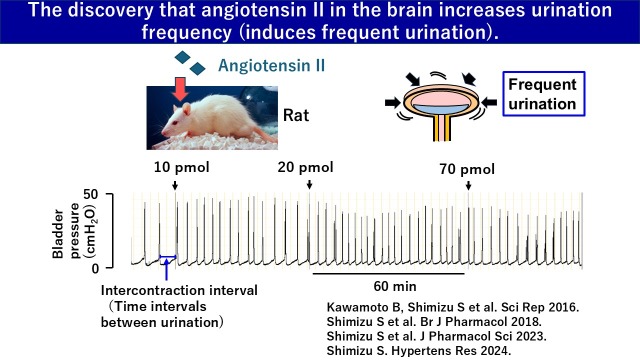Research
The elucidation of the neural mechanism behind emotional behavior and smell
The sense of smell is a sensory system directly coupled with sensory input but behavioral output is often driven by strong emotions and motivations. When attracted to a scent, behavior and motivation shifts to find the scent favorable and desire the scent whereas when avoiding a scent, behavior and motivation shifts to dislike and evade the scent. Such behaviors are newly learned from the individual’s experiences.
In our research, we are interested in identifying what area of the neural circuits synaptic plasticity occurs when encountering a new scent. By the electrophysiological recordings in various regions of the olfactory bulb and cortex of an active mouse, we examine how changes in information processing and interaction among these regions occur as a result of emotional behavior learning. We are attempting to understand the mechanism of neural plasticity that links sensory input to emotional behavior.
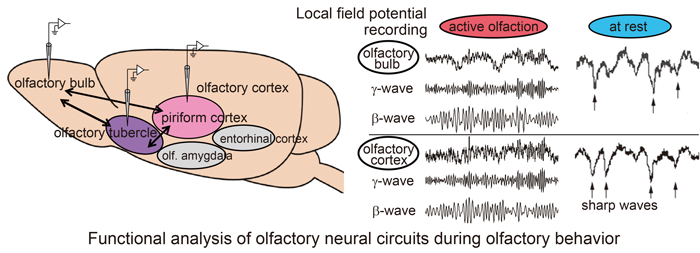
The elucidation of incorporation mechanisms of newly generated neurons
One of the most prominent features of olfaction is that new neurons are formed even after reaching adulthood (adult neurogenesis). Though the adult brain does not normally form new neurons, the olfactory bulb, the first relay of sensory processing, is constantly incorporating new neurons into its neural circuitry, contributing to a high level of plasticity within the olfactory system. From our research, we have determined that the incorporation of new neurons is a result of interactions between two synapses: input of smell from the periphery, and central input from the olfactory cortex of the upper central nervous system. Our goal is to uncover the cellular mechanism behind how two synaptic inputs come together and how the unification is controlled as well as uncovering the biological implications of the central synaptic input. We are currently using techniques such as virus-mediated cell labeling and functional molecular expression, and optogenetical control of synaptic input. Using this knowledge, we hope to contribute to the fields of neuronal regeneration and transplantation.
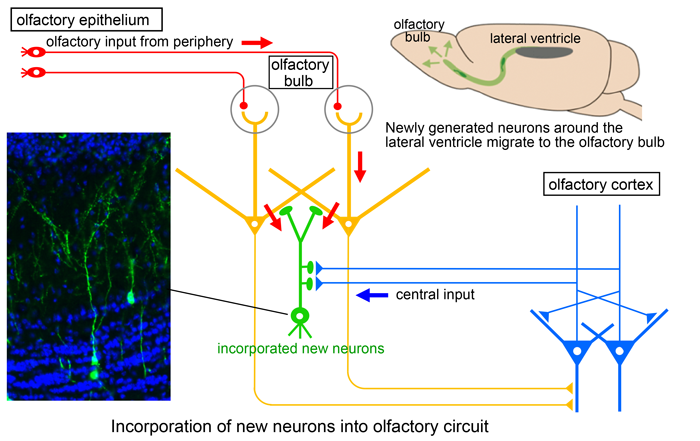
The elucidation of changes to the neural circuit accompanying pheromonal recognition memory
A higher level function of the brain, the mystery of learned behavior (and how the mechanism works) is an issue that has been a great point of interest for both neurobiologists and neuroscientists alike. In order to uncover the mysteries behind the neural mechanisms involved in learning memory, we use pheromonal recognition memory, taking advantage of copulatory stimulus in female mice when the memory of the male scent is imprinted. In addition, we have taken morphological and behavioral approaches to prove that this pheromonal recognition memory is aided by synaptic plasticity formed in the accessory olfactory bulb (at the first relay of the vomeronasal system).
We also aim to analyze the change in neural circuits from pheromonal recognition memory at a cellular level. Specifically, we focus on the synaptic interactions between mitral cells and granule cells, one of the main neural circuits within the accessory olfactory bulb. Through the use of electrophysiological techniques and Ca2+ imaging, we analyze how the presence or absence of pheromonal recognition memory affects the neural pathway. Furthermore, we are trying to determine the functional molecule (synthetic enzyme protein) involved in the transformation of these neural circuits.
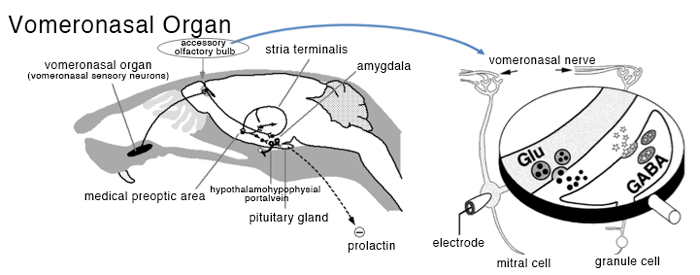
The elucidation of individual (genealogical) recognition mechanism
An individual can produce a variety of chemical compounds and within these compounds are qualities, or markers, which can be used to identify the individual. In rodents, the volatile and non-volatile peptides secreted from one specimen are used in helping other species identify the breed, gender, reproductive condition, and genetic qualities of the individual in an informational code package of scent received via the sensory cells of the vomeronasal organ. There are only a few substances that have been determined to help animals identify each other such as the MHC class I peptide ligand and the Major Urinary Protein (MUP). In our research, we hope to uncover a new recognition substance involved in the breeding-recognition mechanism by using the lineage-specific pregnancy block (the Bruce effect) found in inbred mice with wild mice.
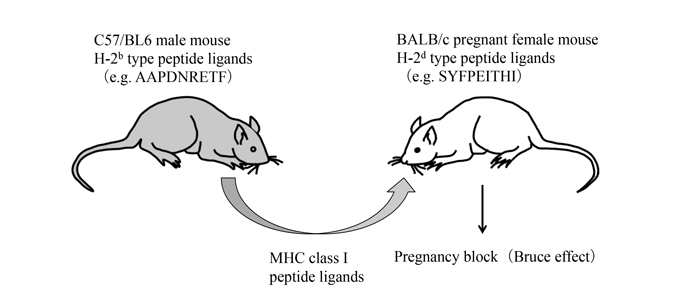
Figure. MHC class I peptide ligands: a key factor in understanding individual recognition
The elucidation of neural mechanisms which aid feeding behavior
Food is not only vital for life but is, at the same time, one of life’s greatest joys. It has been discovered that your eating habits in your early years will ultimately continue to affect your feeding behavior over your lifetime and that eating is not only a means of maintaining health in the elderly, but also has become an important part of daily life. Understanding the mechanisms behind feeding behavior will immensely contribute to the way in which we understand how to have healthy and fulfilling lives. From our research with mice, we have learned that feeding is heavily dependent on smell and that a greatly appetizing smell that makes one think “I want to eat it” will create motivation, activating a specific area within the olfactory tubercule (a subarea in the olfactory cortex). We will continue to research this region from the basics such as the construction of neural pathways, development, and plasticity resultant from feeding experience and widen our understanding as to how this affects humans in terms of functionality and feeding-related diseases.
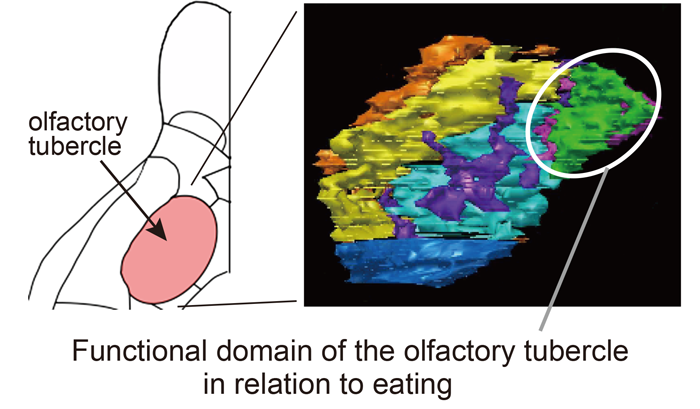
The mechanisms of urination and storage, and elucidation of urinary disorders
The physiological role of the lower urinary tract, comprising the bladder and urethra,
is to store urine (urinary storage) and expel it (urination).
These functions are controlled not only by the peripheral nervous system but also by the central nervous system, which includes the brain and spinal cord.
However, aging and various diseases can impair these functions, resulting in urinary disorders.
Troubles such as frequent urination, waking up multiple times at night to urinate, weakened urinary stream, or urinary leakage significantly lower the quality of life.
With the increasing aging population, there is a strong societal demand for elucidating the mechanisms of urinary disorders and identifying new therapeutic targets and treatments.
Currently, our research focuses on the brain's regulation of the bladder to elucidate the mechanisms of urination and storage as well as the pathophysiology of urinary disorders.
We have demonstrated that angiotensin II, a bioactive substance produced in the body, increases the frequency of urination through angiotensin II receptors in the brain. This finding suggests that brain angiotensin II receptors could serve as potential therapeutic targets for treating frequent urination.
